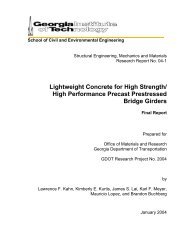Special-Uses-Alkali - Expanded Shale & Clay
Special-Uses-Alkali - Expanded Shale & Clay
Special-Uses-Alkali - Expanded Shale & Clay
Create successful ePaper yourself
Turn your PDF publications into a flip-book with our unique Google optimized e-Paper software.
5. CONCRETE PHYSICAL PROPERTIESAll of the materials tested for ASR expansion mortar bar tests were tested as modifications to theapproved Class D mix design. The three expansion tests indicated a replacement level of cementthat would yield an expansion of less than 0.10% at 14 days. This replacement level was used tomodify Grand Junction Ready Mix’s CDOT Class D mix with the following specifications: 0.44max w/c ratio, 5-8% air content, 615 to 660 pounds of cementitious, and 4,500 psi fieldcompressive strength at 28 days. All of the concrete batch information stayed the same, whilevarying the pozzolans in the mixes. Because of the varying properties of the pozzolans, the batchwater per cubic yard could not be held constant.Instead, the water was adjusted for all the mixes. Almost all the mixes showed no air entrainmentwhen tested. The amount of air entraining admixture recommended by Grand Junction ReadyMix design was even doubled in an effort to get the air content up, but this was still not effective.Later, when confirming the approved mix design, the air entrainment listed was 1.0 ounce (oz.)per cubic yard, when the actual amount needed was 5.3 oz. per cubic yard. Because slump wasnot achieved from air, there are varying swings of w/c ratios. Each mix had air, slump andcylinders cast. The cylinders were tested for compressive strength at 7, 28, and 56 days whilesome cylinders were also used for rapid chloride permeability tests (permeability measured at 56days will typically be lower than specimens tested at 28 days), the raw data results from this testhad to be modified in accordance with the standard, because of the use of a non-standarddiameter test specimen. All testing was performed in general accordance with the applicableASTM standards. All mix design sheets can be found in Appendix E. The individual mixes arediscussed below with the data summarized in Table F.5.1. Baseline CDOT Mix DesignThe San Juan generating station Class F had a slump of 6 inches, air content of 2.0%, and a unitweight of 145.2 pcf. This slump was achieved with a w/c ratio of 0.47. However, with theconsideration of less batch water, the mix would still be very workable and the maximum w/cratio of 0.44 could be easily maintained. The compressive strength values were 3,200 psi, 5,080psi, and 6,570 psi at 7, 28, and 56 days, respectively. The rapid chloride permeabilities of thespecimens were 4,816 and 4,903 coulombs with an average of 4,860 coulombs.22















